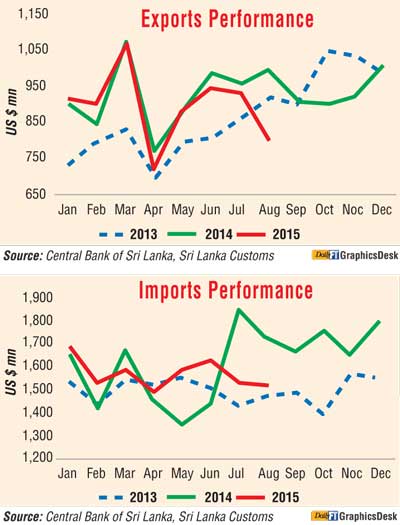Thursday Jan 08, 2026
Thursday Jan 08, 2026
Friday, 23 October 2015 00:05 - - {{hitsCtrl.values.hits}}
The country’s exports have dipped sharply by 19.5% in August to $ 779 million whilst imports continue to soar.
All major export categories have suffered declines in August. On a cumulative basis, export earnings declined by 3.4%, year-on-year, to $7.14 billion during the first eight months of 2015 largely due to weak global demand.
Expenditure on imports in August 2015 declined by 11.7%, year on year, to $ 1,523 million whilst the figure in the first eight months was 
On a cumulative basis, expenditure on imports during the first eight months of 2015 rose by $4 million to $12,559 million, despite the significant drop in international commodity prices, especially fuel.
The deficit in the trade account in August 2015 contracted marginally by 1.0% to $724 million in comparison to $732 million recorded in August 2014. However, on a cumulative basis, the trade deficit during the first eight months of 2015 increased by 5.0% to $5,412 million.
According to the Central Bank the lower earnings from tea, textiles and garments, transport equipment and rubber products mainly contributed to the overall decline in exports earnings during the month.
Earning from tea exports in August 2015 declined by 33.9% to $92 million due to the combined effect of lower export volumes and prices. Tea export earnings from Russia and the Middle East declined, year-on-year, by 38.6% and 38.3%, respectively, during the month owing to the substantial decline in oil revenue of those countries.
Export earnings from textiles and garments, which accounted for half of the exports in the month, declined by 6.6%, reflecting a reduction in exports to the EU market for the sixth consecutive month.
Meanwhile, export earnings from transport equipment decreased by 85.9%, year-on-year, mainly due to higher exports in August 2014 largely due to the export of a cruise ship.
Earnings from rubber product exports declined during the month due to the drop in the exports of rubber tyres. Exports of seafood declined by 41.7% due to an 88.3% decline in seafood exports to the EU market reflecting the impact of the ban on exports of fisheries products to the EU from Sri Lanka.
Export earnings from petroleum products declined marginally by 0.2% in August 2015 compared to the corresponding month of the previous year.
Gems, diamonds and jewellery, machinery and mechanical appliances, food beverages and tobacco are the other export categories that largely contributed to the overall decline in export earnings during the month.
However, spices and unmanufactured tobacco, categorised under agricultural exports, and printing industry products, categorised under industrial products recorded a growth during the month.
The leading markets for merchandise exports of Sri Lanka during the first eight months of 2015 were the USA, UK, India, Germany and Italy accounting for about 51% of the total exports.
Expenditure on imports in August 2015 declined by 11.7%, year on year, to $ 1,523 million. Despite the considerable expansion in import expenditure on consumer goods and investment goods, a substantial reduction in intermediate goods imports mainly due to a significant decline in fuel imports led to this decline.
The drop in international oil prices to a six year low level in August 2015 together with the decline in the import volume of refined petroleum resulted in a 60.5% reduction in the fuel import bill. In addition, import expenditure on textiles and textile articles and wheat and maize also declined by 28.0% and 65.5%, respectively, on a year-on-year, contributing considerably for the decline in import expenditure in August 2015.
The 56.9% increase in the expenditure on importation of motor vehicles for personal usage, mainly contributed for the increase in consumer goods imports. Despite the marginal decline in import expenditure on machinery and equipment and building materials, a significant increase of 95.0% in imports of transport equipment contributed to the 8.9% increase in investment goods imports.
High expenditure on imports of auto-trishaws and tractors mainly contributed to the increase in importation of transport equipment.
During the period from January to August 2015, the main import origin countries were India, China, Japan, UAE and Singapore accounting for about 61% of total imports.